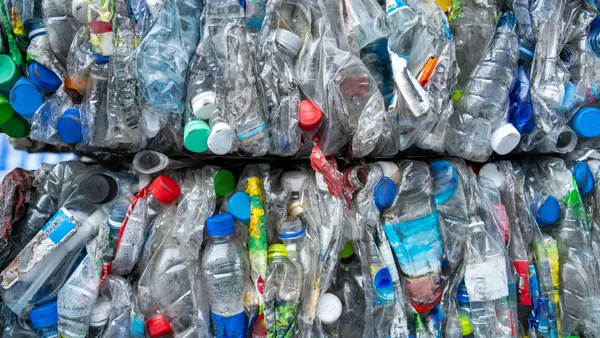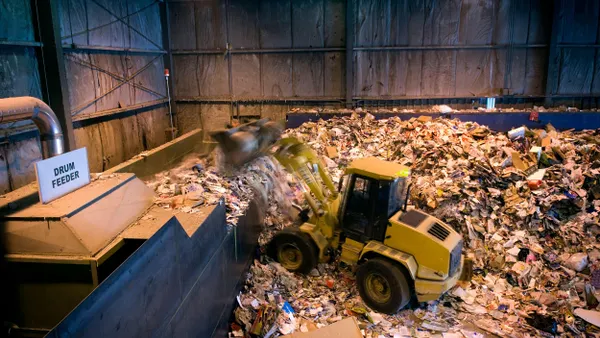Dive Brief:
- Maine’s Department of Environmental Protection has extended the deadline for submitting final comments on the draft rules for the nation’s first extended producer responsibility law for packaging. The deadline has been moved to Oct. 31.
- The state has been going through a lengthy stakeholder engagement process since passing its EPR for packaging law in 2021. This comment period is the last time DEP will accept formal feedback on the proposed details before it presents the draft rules to the Board of Environmental Protection in December to start the formal rulemaking process. Most rules aren’t expected to be finalized until 2025.
- The draft rules include numerous proposed implementation details and metrics. It calls for producers to achieve an overall packaging recycling rate of 40% between 2030 and 2039. Packaging should have at least 10% postconsumer recycled content during that same period. Meanwhile, municipalities must collect at least 60% of readily recyclable packaging from 2030 to 2034, according to the draft.
Dive Insight:
Numerous recycling and waste stakeholders are keeping a close eye on Maine’s EPR for packaging rulemaking process since it’s the first of its kind in the U.S. Though the law laid out a general EPR framework, the draft rules spell out critical details dictating everything from how much producers pay into the program to what waste reduction and recycling targets they must meet over time.
Two parts of the detailed draft rules have been released so far, which cover topics such as program goals, municipal reimbursements, criteria for determining what materials are “readily recyclable,” and the program’s fee structure. DEP said in email that it expects to publish a third and final part with additional details soon.
Maine’s law covers most types of consumer packaging and will require that producers make payments to a stewardship organization. The amount each producer pays will be based on the volume it generates, but also on how recyclable or reusable its packaging is, according to the draft rules.
The EPR fund will collect money needed to reimburse municipalities for certain recycling and waste management costs, but it could also be used to fund recycling infrastructure projects or educational outreach.
Maine’s EPR model differs from other programs recently passed in California, Oregon and Colorado. Maine’s law is considered a full municipal reimbursement model, meaning the producers pay fees but leave collection duties to the municipalities. In California and Oregon, it’s a shared responsibility model in which municipalities still get reimbursed, but producers and municipalities share collection duties. In Colorado, producers will fund a statewide recycling program and take a role in managing it.
An important feature of this EPR program is the “readily recyclable” definition for packaging materials. Municipalities must be able to provide collection and recycling services for all readily recyclable materials to participate in the program, and certain metrics and producer responsibilities are based around which types of materials are accepted in the program.
The definition is a particularly important focus for MRF operators, some of which weighed in on the possible definition at a meeting earlier this year.
The department will publish a draft list of proposed packaging material types, as well as a list of what is considered “readily recyclable,” within 90 days after the EPR rules are adopted. DEP expects to hold an additional stakeholder process just on those lists. After feedback from recyclers at the meeting in March, the draft now says it “will make reasonable efforts to ensure recycling establishments and potential stewardship organizations are present.”
DEP also plans to review the list each year and make changes as needed, a process in which recyclers have also asked to participate. Casella Waste Systems is among the companies requesting to be involved in discussions.
“It is important to recognize that while other stakeholders may wish to be heard on this topic, it would not make sense for them to dictate what is processed through our facilities,” said Bob Cappadona, Casella’s vice president of resource solutions, in a March statement.
Maine’s draft rule documents also lay out numerous program goals that direct producers to reduce packaging weight over time, use more reusable packaging and gradually add more postconsumer recycled content. In many cases, producers will be hit with heavy fines for not complying.
“We believe Maine’s packaging EPR law represents a major opportunity to accelerate packaging reduction and reuse throughout the state,” said Sydney Harris, policy director at Upstream, in public comments earlier this year.
The draft rules propose an overall packaging recycling rate graduaally rise from a 40% rate by 2039 to an up to 80% rate between 2040 to 2049. It must hit 90% from 2050 onward, according to the draft.
It also dictates packaging should go from having at least 10% postconsumer recycled content in 2039 to having 20% between 2040 and 2049, and hitting 30% after 2050.
Participating municipalities face specific responsibilities too. The draft specifies municipalities must go from collecting at least 60% of readily recyclable packaging in 2034 to 80% from 2035 to 2039. It must collect 90% or more from 2040 on. The draft rules also lay out proposed calculations municipalities can use for reimbursements.
The draft rules also call for audits that sample the makeup of certain areas of litter determine how much of it is packaging. DEP could decide to fund litter education programs, for example, depending on the audit’s outcome.
The draft rules also lay out details of producers’ registration and material reporting requirements, as well as tiers of fines or credits a producer could incur or gain based on how well they meet detailed recycling, postconsumer content and other metrics.
DEP expects the board to adopt the final “routine and technical” rules of the EPR program by the summer of 2024. The final adoption of what it considers “major substantive rules” could come in the summer of 2025, after they are approved by the state legislature and then the board.










